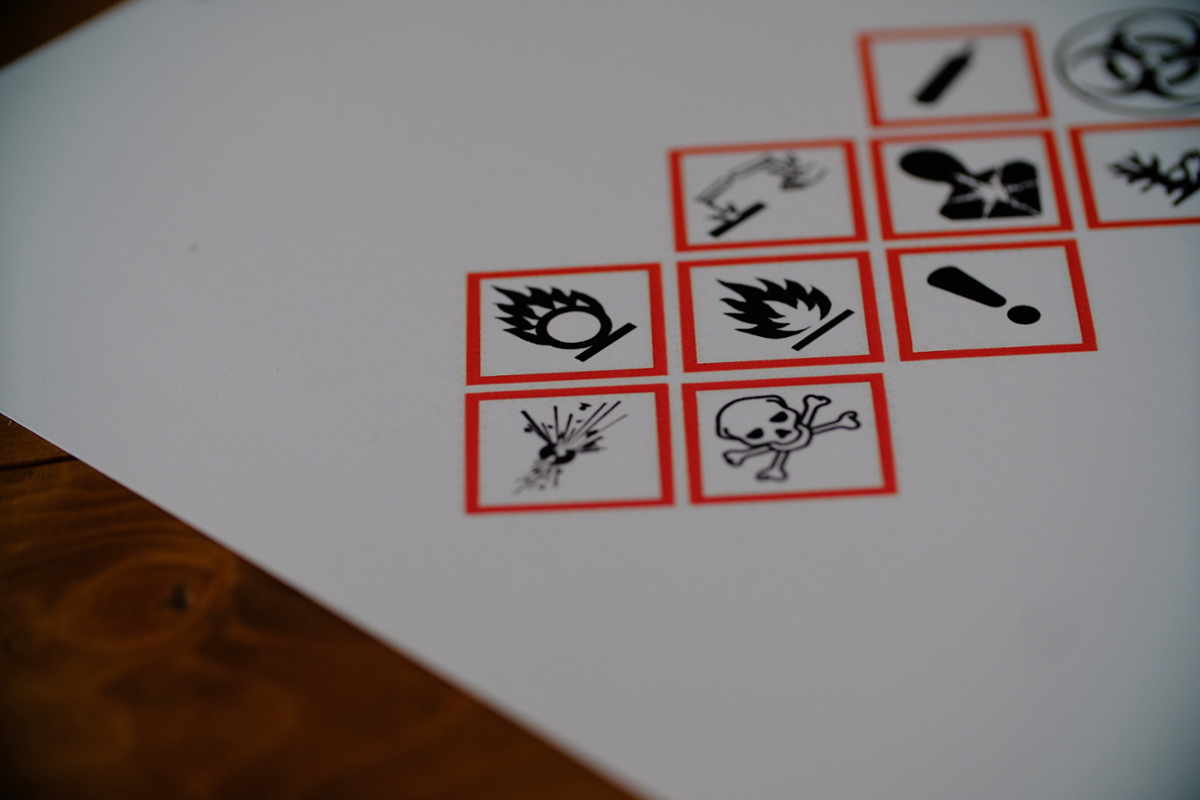
Maximum Allowable Quantities (MAQ) of Hazardous Materials
Updated October 22, 2024
Overview
Maximum Allowable Quantities (MAQs) are the maximum amount of hazardous material allowed to be stored or used within a control area inside a building or an outdoor control area. The California Fire Code (CFC) and California Building Code (CBC) establish these limits, which are broken down by hazard class and physical state (solid, liquid, or gas). Compliance with Fire Code hazardous materials regulations ensures that the minimum level of fire and life safety is met for building occupants and first responders.
MAQ limits are dependent on how the buildings are constructed, whether they have full automatic fire sprinkler coverage, and other variables such as which floor/level chemicals are being stored and used. MAQ limits are more restrictive for highly hazardous chemicals and on upper floors (above 3rd story).
Determining MAQs relies on many factors, including:
- Quantities of hazardous materials
- Types of hazardous materials
- Physical state of hazardous materials
- Method of storage and use
- Occupancy type
- Building and construction attributes
- Building ventilation and automatic fire suppression system (sprinklers)
In 2019, UCOP assembled a MAQ Task Force to address MAQ issues at all UC locations. The task force issued a report in 2023 and UC President Drake then issued a letter with his support and directives to each UC location.
Control Areas
A space within a building where quantities of hazardous materials not exceeding the maximum allowable quantities (MAQs) per control area are stored, dispensed, used, or handled. Control areas can be indoors or outdoors. A single control area can span an entire building, floor, room, or contiguous suite of rooms. However, they must be separated from other control areas by fire-resistance rated construction.
- Must be separated from each other by fire-resistance rated barriers on all six sides (floor, ceiling, 4 walls)
- Number of control areas allowed and MAQs per control area vary with floor level, sprinkler status, and storage conditions of chemicals
- Lab A + Lab B + Lab C + … Lab X = TOTAL Control Area MAQs
- Example building: 6 control areas, 63 hazard classes
- Out of compliance hazard classes:
- 1st Floor A: 1/63
- 1st Floor B: 0/63
- 1st Floor C: 0/63
- 2nd Floor B: 2/63
- 2nd Floor C: 0/63
- 2nd Floor D: 0/63
- 2/6 control areas out of compliance (33%)
2B 2C 2D 1A 1B 1C
- Out of compliance hazard classes:
- Example building: 6 control areas, 63 hazard classes
Hazard Categories
The California Fire Code (CFC) regulates hazardous materials that pose physical or acute health hazards. Materials are classified according to their CFC definitions for MAQ and regulatory purposes. These definitions are not always in alignment with OSHA definitions, which are based on the United Nation’s Globally Harmonized System of Classification and Labelling of Chemicals (GHS).
Per CFC, chemical mixtures shall be classified with hazards of the mixture as a whole. Mixtures of hazardous materials shall be classified in accordance with nationally recognized reference standards; by an approved qualified organization, individual, or Safety Data Sheet (SDS); or by other approved methods.
|
California Fire Code Physical hazards include
|
California Fire Code Health hazards include
|
Roles & Responsibilities
Researchers (PIs, Post-Docs, Graduate Students)
What are MAQs and how do they impact me?
MAQ limits for your lab are impacted by your specific building and lab space. For many buildings, you share the MAQ limits with other labs on the same floor as you. In other spaces, your lab may be surrounded on all sides by fire-resistant rated construction, keeping it as a separate “control area” from neighboring labs. If your lab is separated, MAQ limits are restricted to your individual control area.
Upper floors (higher than 3rd story) and basement floors (below ground level) are more challenging for occupants to evacuate during emergencies. These upper and lower levels are also more challenging for first responders to access; therefore, MAQ limits are reduced on higher and lower levels relative to the first floor.
In many cases, your lab will need to reduce chemical quantities in order to be compliant with the California Fire Code. Operationally, this could mean lab cleanouts and removal of older chemicals, more frequent orders of common chemicals in smaller quantities (rather than bulk), sharing common chemicals within your lab (rather than each researcher having their own container), and reliance on stock rooms or re-use facilities for some chemicals.
Contact EHS or your Campus Fire Marshal to learn more about MAQ limits for your lab and control area.
What are my responsibilities?
- Ensure lab’s chemical inventory is up to date. Add and remove chemical containers in real time and reconcile at least once per year.
- Dispose of old, expired, and non-viable chemicals whenever possible.
- Pursue less hazardous alternatives wherever possible.
- Understand the specific MAQ limits for your control area by hazard class.
- Analyze current and future research needs and coordinate with UCI EHS, Fire and Life Safety, and Facilities Management to ensure the lab is equipped to store necessary hazardous materials.
Building Facilites/Space Manager
How do MAQs affect space assignments for chemical users in my building?
For building managers responsible for assigning new faculty to spaces, it is prudent to discuss the limitations of that space with EHS or the Campus Fire Marshal prior to space assignments. For example, synthetic chemistry research or users of toxic gases will be severely restricted on upper floors of most buildings.
MAQs and control area boundaries must be considered when planning new construction or renovation, such that any changes in infrastructure do not affect the integrity of the fire-rated construction that segregates control areas from one another.
Executive Leadership (VCs, Deans, Department Chairs)
UC Irvine is required to meet compliance with MAQs by 2030. UC Irvine has an Executive Official responsible for assuring our campus buildings are on track towards MAQ Compliance on or before this date.
Environmental Health & Safety (EHS)
EHS staff assist in managing chemical inventories for UC Irvine and are familiar with RSS Chemicals, but PIs and researchers are ultimately responsible for updating their chemical inventory. EHS acts as the liaison between chemical users and regulatory agencies and the Campus Fire Marshal, and are familiar with the objectives of MAQ compliance and how they impact chemical users.
Campus Fire Marshal
The Campus Fire Marshal identifies control areas and/or lab suites for buildings at UCI. This is accomplished by identifying fire-resistant rated construction from record drawings. Fire barriers used to separate control areas are field verified for integrity.
Design & Construction Services
Fire Code Maximum Allowable Quantities (MAQs) are limits on types and quantities of hazardous materials (chemicals) that can safely be stored and used in buildings. MAQ limits are dependent on how the building is constructed, whether it has full automatic fire sprinkler coverage, occupancy type, and other variables such as which floor/level chemicals are being stored and used. For all new projects (new building or TI project), inquire as to whether or not any hazardous materials will be stored in the new space. Labs, shops, storage facilities, diesel generators, research support buildings, energy storage, facilities supporting custodial or maintenance are some examples of spaces which may contain hazardous chemicals.
In the earliest planning phases, discuss any planned chemical storage with your Campus Fire Marshal. They can provide guidance on the most appropriate type of building and/or occupancy type for planned chemical usage. Hazardous Materials Inventory Statements (HMISs) will be required prior to submittal of new projects.
Fire Code Maximum Allowable Quantities (MAQs) vary tremendously on building attributes such as sprinkler coverage, fire-resistant rated construction, and where hazardous materials are being stored and used. Upper floors (higher than 3rd story) are more challenging for occupants to evacuate during emergencies. These upper levels are also more challenged for first responders to access, therefore the MAQ limits are reduced on higher levels relative to the first floor.
Frequently Asked Questions (FAQs)
Determining MAQs is complex and relies on several structural and operational factors.
The most common factors that determine MAQs at UCI are:
► Which floor your lab is located (see Fig. 1 below)
► Whether a fire sprinkler system is installed throughout the building
► Use of approved storage cabinets
As emergency response and egress become increasingly difficult with building height, the quantity of hazardous materials that can be safely used and stored decreases. For example, the MAQs on floors 9th and above are 5% of those allowed on the 1st floor.
On the other hand, if the entire building is equipped with a sprinkler system or approved storage cabinets, the MAQ may be increased if all fire code requirements are met.
Please contact EHS at 949-824-6200 or email safety@uci.edu for information about your MAQ status and whether you are compliant.
MAQs are set by the Fire Code to keep building occupants and first responders safe. Exceeding MAQs puts everyone at risk and is considered a serious offense. If your control area exceeds the MAQ, EHS will contact you with recommended corrective actions.
Examples of corrective actions include decreasing the quantities of hazardous materials you store and using approved storage cabinets.
UC Chemicals: Searching your chemical inventory by hazard class will provide a list of chemicals that fall into that hazard.
1. Search your UC Chemicals inventory for the hazard category of interest.
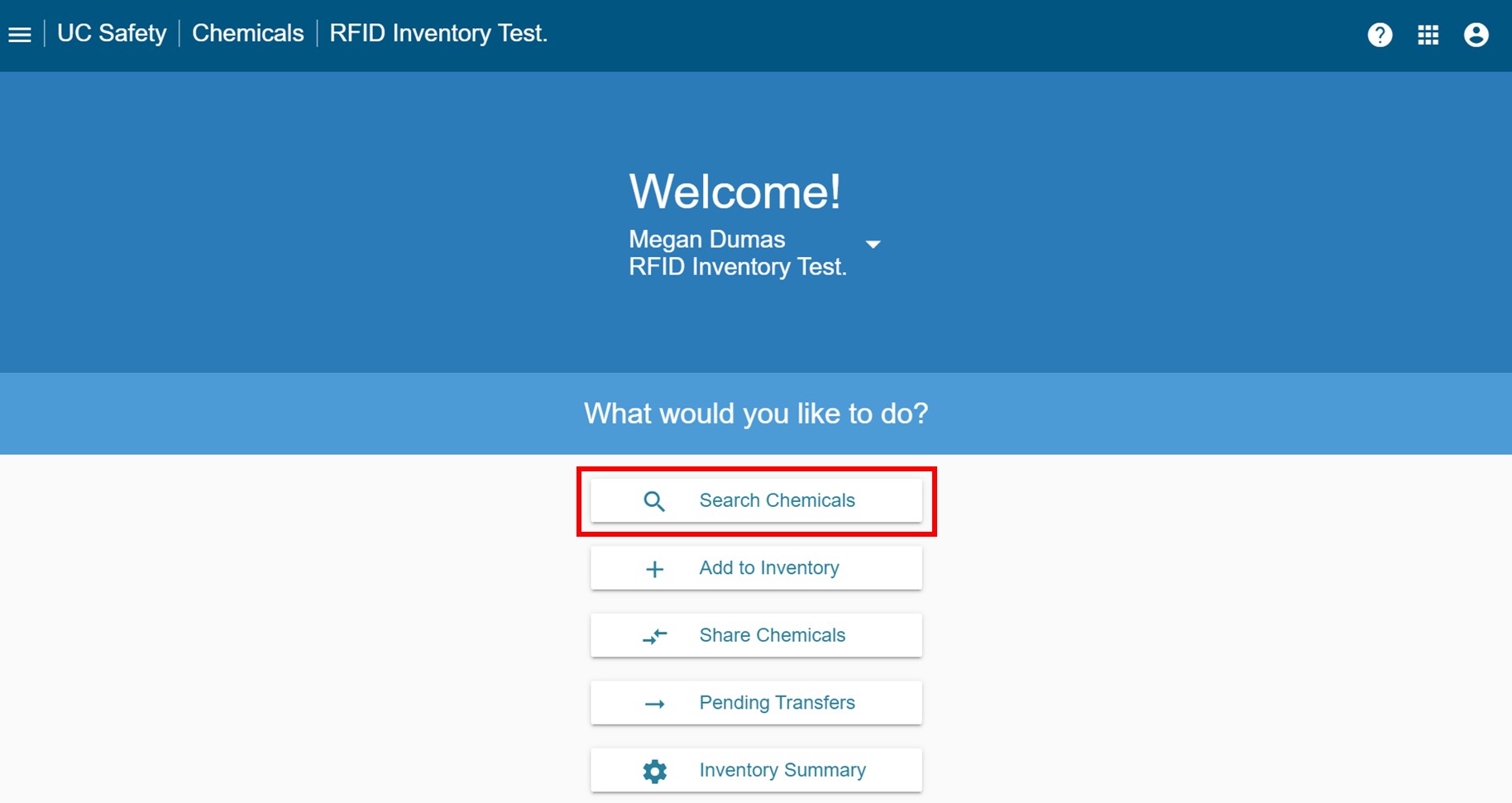
2. Select Advanced Search
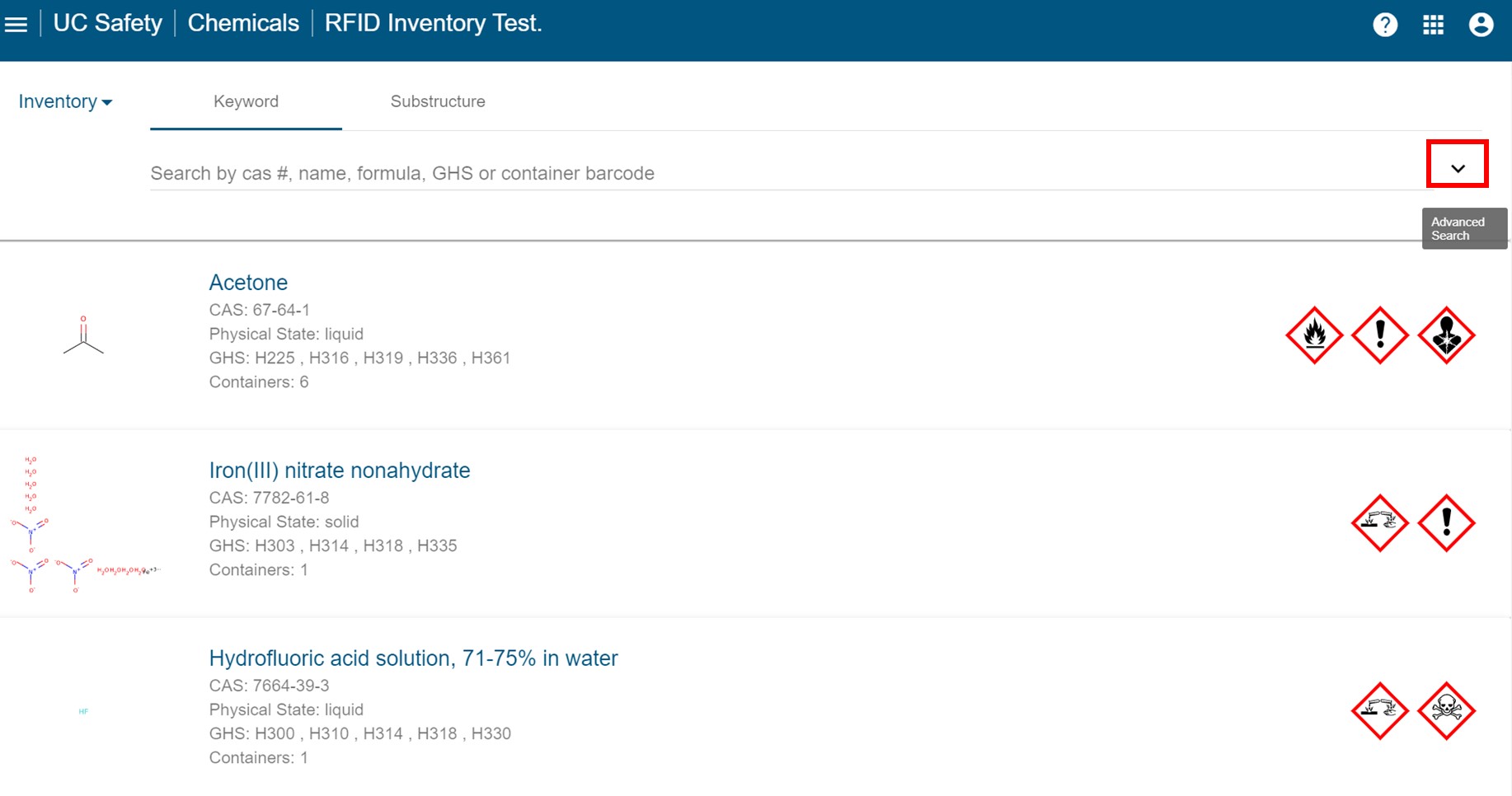
3. Select the “Classification” dropdown menu
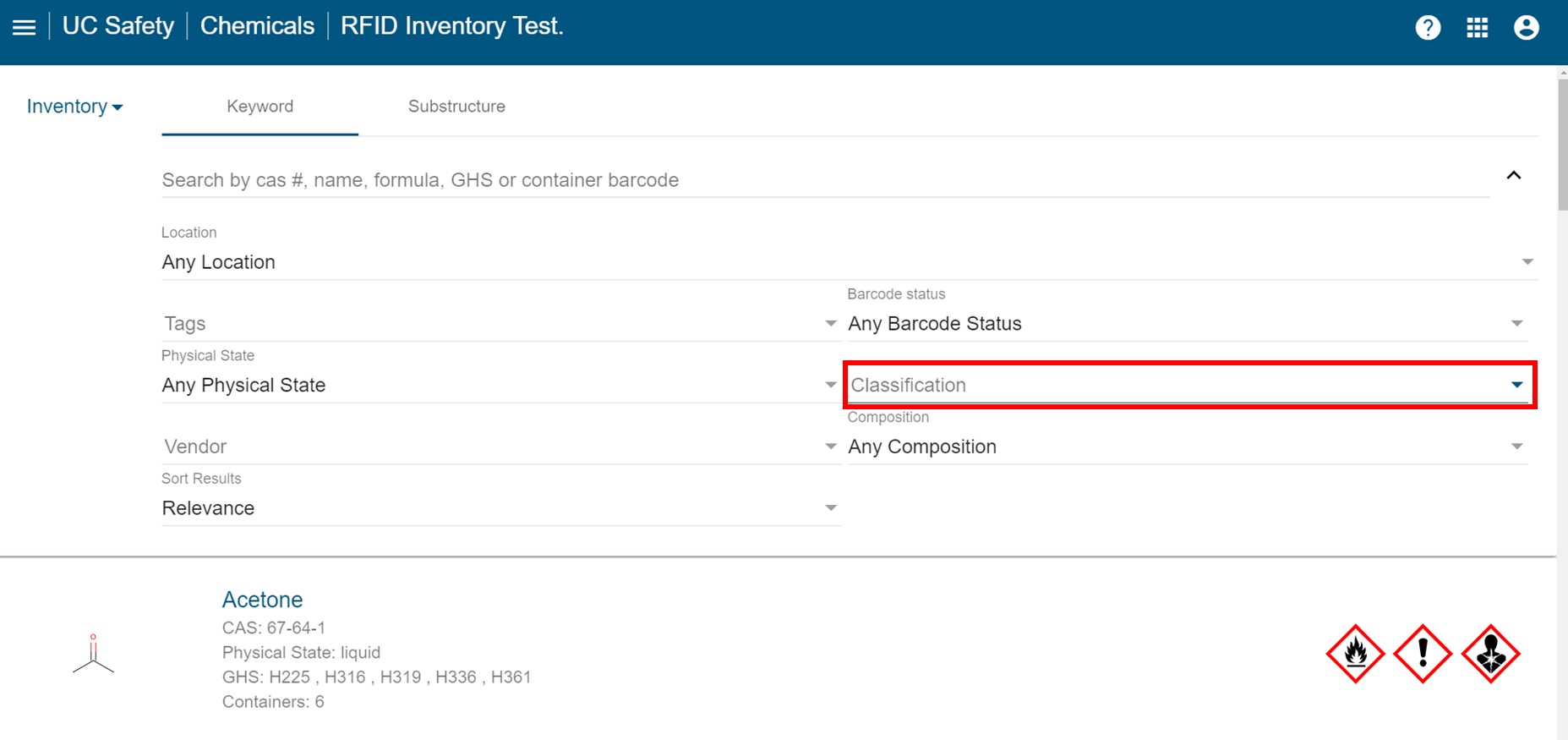
4. Once the classification is selected the search will automatically update.
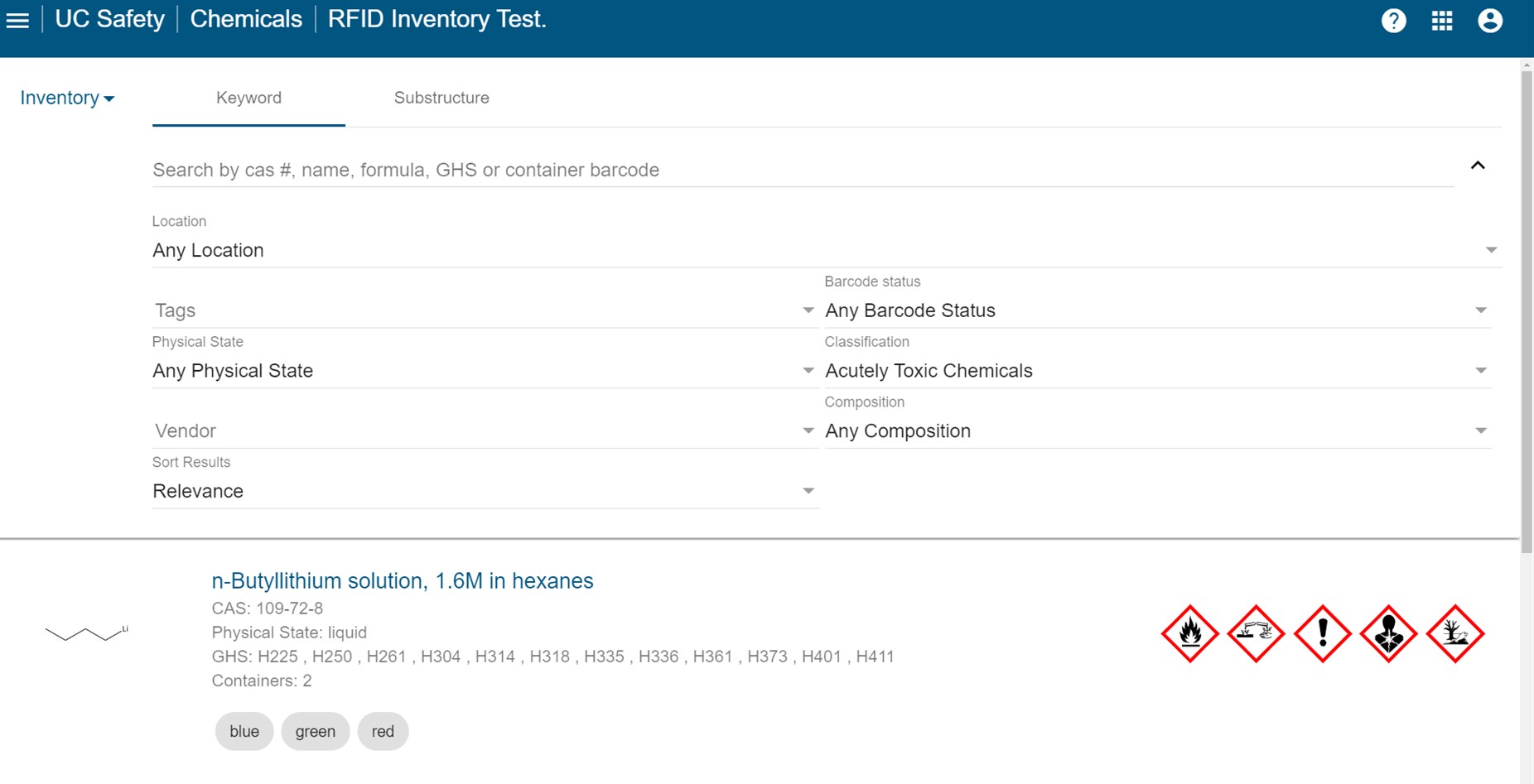
Strategies to reduce the chemicals you store include:
- Purchase smaller quantities of chemicals (e.g. 1 L rather than 4 L)
- Do not purchase duplicate chemicals or cases
- Share chemicals where possible
- Maintain an accurate inventory
- Update your online inventory every time a chemical is purchased or discarded
- Reconcile your inventory at least annually
- Dispose of any expired or unneeded chemicals and update your inventory
- Consolidate chemicals since each bottle counts as if it were full
MAQs are largely determined by building construction. Building construction (e.g. installing fire sprinklers and fire rated walls) can increase the limit; however it can be very costly.
MAQs can also be increased by storing all chemicals in approved storage cabinets (e.g. flammable storage cabinets, gas cabinets). Due to their complexity, MAQ increases must be addressed on a case-by-case basis.
It is a major safety issue if a MAQ is exceeded and unable to be resolved. The issue will be escalated to Campus leadership and enforcement will be determined on a case by case basis.
MAQs have always been enforced at UCI. However, this process is lengthy, expensive, and each individual control area needs to be evaluated.
UCI is in the process of implementing a new chemical inventory software (UC Chemicals) that allows facile and quick reports of MAQ compliance in real time.
As the campus grows, new PIs are added, and current PIs move into renovated spaces as MAQ issues are identified and evaluated.
- Update and reconcile chemical inventory regularly for accuracy.
- Reduce quantities.
- Order chemicals strategically.
- Implement Approved Storage.
- Consider moving location of lab.
- Construct new buildings.
- Renovate/retrofit existing buildings.